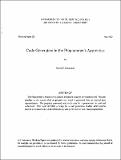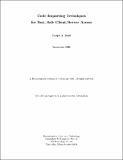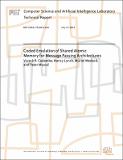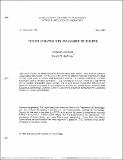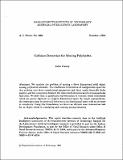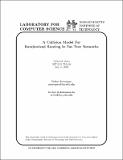Browsing Computer Science and Artificial Intelligence Lab (CSAIL) by Title
Now showing items 488-507 of 3804
-
Code for Java Libraries for Accessing the Princeton Wordnet: Comparison and Evaluation
(2013-11-01)This archive contains the code and data for running the evaluations described in: Finlayson, Mark Alan (2014) "Java Libraries for Accessing the Princeton Wordnet: comparison and Evaluation" in Proceedings of the 7th Global ... -
Code for LOLCAT Method (Variant of Gillespie Algorithm)
(2009-09-04)This code and data is publicly listed code for the LOLCAT Method developed by Sagar Indurkhya and Jacob Beal, in the paper: "Reaction factoring and bipartite update graphs accelerate the Gillespie algorithm for large-scale ... -
Code Generation in the Programmer's Apprentice
(MIT Artificial Intelligence Laboratory, 1982-05)The Programmer's Apprentice is a highly interactive program development tool. The user interface to the system relies on program text which is generated from an internal plan representation. The programs generated need to ... -
Code-mapping Policies for the Tagged-token Dataflow Architecture
(1988-05)Multiprocessing seems to be the only viable way to gain significant speedup beyond that afforded by performance advances in semiconductor devices and hardware construction, which are beginning to face the limitations of ... -
Coded Emulation of Shared Atomic Memory for Message Passing Architectures
(2013-07-17)This paper considers the communication and storage costs of emulating atomic (linearizable) read/write shared memory in distributed message-passing systems. We analyze the costs of previously-proposed algorithms by Attiya, ... -
A Coded Shared Atomic Memory Algorithm for Message Passing Architectures
(2014-08-01)This paper considers the communication and storage costs of emulating atomic (linearizable) multi-writer multi-reader shared memory in distributed message-passing systems. The paper contains three main contributions: (1) ... -
Codon Constraints on Closed 2D Shapes
(1984-05-01)Codons are simple primitives for describing plane curves. They thus are primarily image-based descriptors. Yet they have the power to capture important information about the 3-D world, such as making part boundaries ... -
Cognitive Cliches
(MIT Artificial Intelligence Laboratory, 1986-04)This paper is an exploration of a wide class of mental structures called cognitive cliches that support intermediate methods that are moderately general purpose, in that a few of them will probably be applicable to any ... -
Cognitive Security for Personal Devices
(2008-03-17)Humans should be able to think of computers as extensions of their body, as craftsmen do with their tools. Current security models, however, are too unlike those used in human minds---for example, computers authenticate ... -
Cognitive-Developmental Learning for a Humanoid Robot: A Caregiver's Gift
(2004-09-26)The goal of this work is to build a cognitive system for the humanoid robot, Cog, that exploits human caregivers as catalysts to perceive and learn about actions, objects, scenes, people, and the robot itself. This thesis ... -
CogSci to AI: It's the Brainware, Stupid!
(2006-03)Current modularization techniques fail when applied to hard AI problems.But cognitive science shows that the mind has modules specialized for particular functions.Unlike current engineered modules, the modules of themind ... -
Coherent Behavior from Incoherent Knowledge Sources in the Automatic Synthesis of Numerical Computer Programs
(1981-01-01)A fundamental problem in artificial intelligence is obtaining coherent behavior in rule-based problem solving systems. A good quantitative measure of coherence is time behavior; a system that never, in retrospect, ... -
Coherent Reaction
(2009-06-12)Side effects are both the essence and bane of imperative programming. The programmer must carefully coordinate actions to manage their side effects upon each other. Such coordination is complex, error-prone, and fragile. ... -
Cohesion in Computer Text Generation: Lexical Substitution
(1983-05)This report describes Paul, a computer text generation system designed to create cohesive text. The device used to a achieve this cohesion is lexical substitution. Through the use of syntactic and semantic information, ... -
Collaborative Diagnosis of Over-Subscribed Temporal Plans
(2016-10-14)Over-subscription, that is, being assigned too many tasks or requirements that are too demanding, is commonly encountered in temporal planning problems. As human beings, we often want to do more than we can, ask for things ... -
Collective Choice with Uncertain Domain Moldels
(2005-08-16)When groups of individuals make choices among several alternatives, the most compelling social outcome is the Condorcet winner, namely the alternative beating all others in a pair-wise contest. Obviously the Condorcet ... -
Collision Detection for Moving Polyhedra
(1984-10-01)We consider the problem of moving a three dimensional solid object among polyhedral obstacles. The traditional formulation of configuration space for this problem uses three translational parameters and three angles ... -
Collusion-Resilient Revenue In Combinatorial Auctions
(2007-11-02)In auctions of a single good, the second-price mechanism achieves, in dominantstrategies, a revenue benchmark that is naturally high and resilient to anypossible collusion.We show how to achieve, to the maximum extent ...

